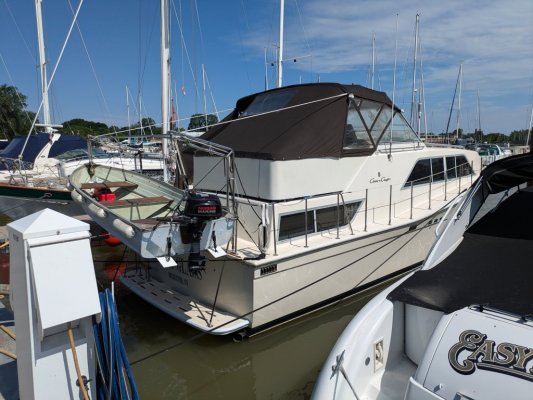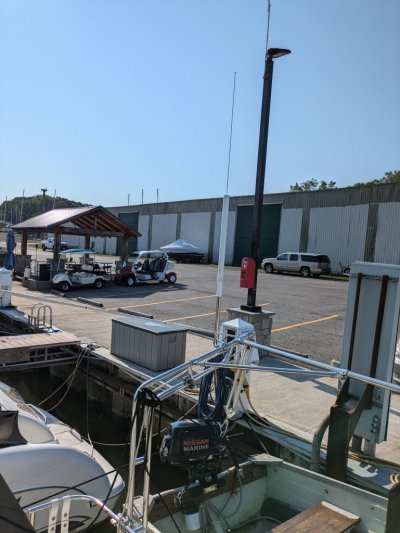rslifkin
Guru
- Joined
- Aug 20, 2019
- Messages
- 7,930
- Location
- USA
- Vessel Name
- Hour Glass
- Vessel Make
- Chris Craft 381 Catalina
I'm planning out some upgrades to my antennas and wanted to tap into the wealth of radio knowledge here.
Currently, I have 2 VHFs on board and just finished up an AIS install. The VHFs each have the common 8' 6db gain antenna (Shakespeare 5225-XT) on them with the antennas mounted approximately midship (on opposite sides of the deckhouse, so they're about 10 feet apart). The new AIS antenna is mounted to the top of the dinghy davits (13 feet aft of the other antennas) and with about1.5 feet of extension between the davits and the base of the antenna. That antenna is a 6db Morad (159mhz center tuning).
Current antenna heights above waterline to the tips of the antennas are just under 17 feet for the VHF antennas, about 15 feet for the AIS antenna. I don't want to raise the AIS antenna any higher, as the goal is to keep that and a possible third VHF antenna (which would go on the other side of the davits 10 feet away from the AIS antenna) at a height where I never have to lower them anywhere we go (lowest bridge I'm accounting for is 15'6").
VHF performance currently is at least good, but I know it can be better. AIS performance seems quite good, as in open water I was tracking freighters reliably at 20 nm and had signal from some as far as 45 nm. Sailboats with Class B (CSTDMA) transceivers were showing up fine from 6 - 7 nm. It seems like not many in our area have B+ (SOTDMA) transceivers, so I only got a small test of how far those would come in, but I picked up one at around 12 miles and another was fine out to about 8 miles (that's as far away as they got before sailing back).
The pictures below show the placement of the antennas. The AIS antenna is well clear of any metal horizontally from it (nearest thing is several feet away, well beyond 1/4 wavelength). The VHF antennas, however, are a bit close to the windshields and bimini frame.
Based on the metal proximity concerns and this boat also being a bit of a lively ride at times, I'm debating between going for the big guns and putting a tall set of 8 or 9db antennas on or getting another pair of the 6db Morads (with 156mhz tuning this time) and putting them on extension poles to get the tips up around 20' above the waterline (which would put the bottom of the antenna above any metal and above a future radar install when the bimini becomes a hard top at some point).
What does everyone here think would be the most effective and practical setup? If I can keep overall height around 20 feet that will reduce how often the big antennas need to be lowered (any travel through the Oswego and eastern Erie canals limits us to 21' clearance), but there's no hard requirement for maximum height beyond not doing anything that would require an impractical mounting setup.
Currently, I have 2 VHFs on board and just finished up an AIS install. The VHFs each have the common 8' 6db gain antenna (Shakespeare 5225-XT) on them with the antennas mounted approximately midship (on opposite sides of the deckhouse, so they're about 10 feet apart). The new AIS antenna is mounted to the top of the dinghy davits (13 feet aft of the other antennas) and with about1.5 feet of extension between the davits and the base of the antenna. That antenna is a 6db Morad (159mhz center tuning).
Current antenna heights above waterline to the tips of the antennas are just under 17 feet for the VHF antennas, about 15 feet for the AIS antenna. I don't want to raise the AIS antenna any higher, as the goal is to keep that and a possible third VHF antenna (which would go on the other side of the davits 10 feet away from the AIS antenna) at a height where I never have to lower them anywhere we go (lowest bridge I'm accounting for is 15'6").
VHF performance currently is at least good, but I know it can be better. AIS performance seems quite good, as in open water I was tracking freighters reliably at 20 nm and had signal from some as far as 45 nm. Sailboats with Class B (CSTDMA) transceivers were showing up fine from 6 - 7 nm. It seems like not many in our area have B+ (SOTDMA) transceivers, so I only got a small test of how far those would come in, but I picked up one at around 12 miles and another was fine out to about 8 miles (that's as far away as they got before sailing back).
The pictures below show the placement of the antennas. The AIS antenna is well clear of any metal horizontally from it (nearest thing is several feet away, well beyond 1/4 wavelength). The VHF antennas, however, are a bit close to the windshields and bimini frame.
Based on the metal proximity concerns and this boat also being a bit of a lively ride at times, I'm debating between going for the big guns and putting a tall set of 8 or 9db antennas on or getting another pair of the 6db Morads (with 156mhz tuning this time) and putting them on extension poles to get the tips up around 20' above the waterline (which would put the bottom of the antenna above any metal and above a future radar install when the bimini becomes a hard top at some point).
What does everyone here think would be the most effective and practical setup? If I can keep overall height around 20 feet that will reduce how often the big antennas need to be lowered (any travel through the Oswego and eastern Erie canals limits us to 21' clearance), but there's no hard requirement for maximum height beyond not doing anything that would require an impractical mounting setup.


